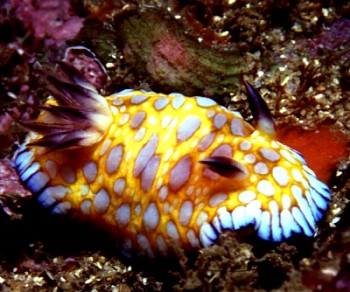
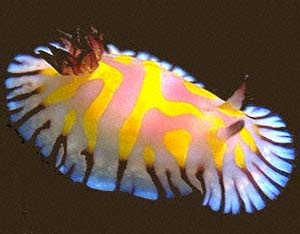
Chromodoris roboi
Gosliner & Behrens, 1998
Order: NUDIBRANCHIA
Suborder: DORIDINA
Family: Chromodorididae
DISTRIBUTION
Tropical Western Pacific.
PHOTO
UPPER: 12 meters, off Kurnell, Botany Bay, Sydney, N.S.W. Australia, 9 April 2000. Approx 2cm long. PHOTO: Akos Lumnitzer.
LOWER: Western Australian specimen with unusual colour pattern of lines rather than spots. Fremantle, near Perth, 30 March 1980. PHOTO: Hanne Just.
See messages below for a range of colour variation.
Reference:
• Gosliner, T.M. & Behrens, D.W. (1998) Five new species of Chromodoris (Mollusca: Nudibranchia: Chromodorididae) from the tropical Indo-Pacific Ocean. Proceedings of the California Academy of Sciences 50(5): 139-165.
Rudman, W.B., 1998 (April 4) Chromodoris roboi Gosliner & Behrens, 1998. [In] Sea Slug Forum. Australian Museum, Sydney. Available from http://www.seaslugforum.net/find/chrorob
Related messages
Chromodoris roboi from Exmouth, Western Australia
April 3, 2008
From: Bruce Potter
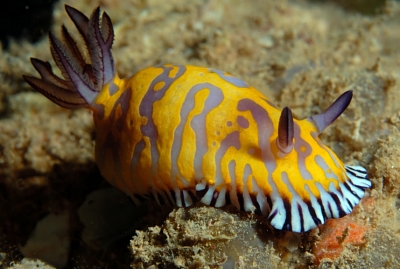
Dear Bill,
While thinking of blue black and orange Chromodorids, I have just noticed that this Chromodoris roboi is also blue black and orange.
I also found this under the Exmouth Navy Pier. It is a beautiful little critter.
Locality: Exmouth, 14metres, Western Australia, Indian Ocean, 5 October 2007, under a jetty. Length: 35mm. Photographer: Bruce Potter.
Regards
Bruce Potter.
bandppotter@bigpond.com
Potter, B., 2008 (Apr 3) Chromodoris roboi from Exmouth, Western Australia. [Message in] Sea Slug Forum. Australian Museum, Sydney. Available from http://www.seaslugforum.net/find/20986Thanks Bruce,
This lined form seems to be most common in Western Australia
Best wishes,
Bill Rudman
Chromodoris cf roboi from Lembeh, Indonesia
January 11, 2006
From: Ken Tucker
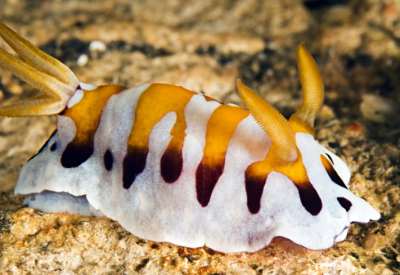
Dear Bill,
Can you suggest an identfication please?
Locality: Indonesia, Lembeh Strait, Reef. Depth: perhaps 30-40 ft. 5 Nov 2005. Photographer: Ken Tucker
Ken Tucker
ken@kilili.com
Tucker, K.C., 2006 (Jan 11) Chromodoris cf roboi from Lembeh, Indonesia. [Message in] Sea Slug Forum. Australian Museum, Sydney. Available from http://www.seaslugforum.net/find/15487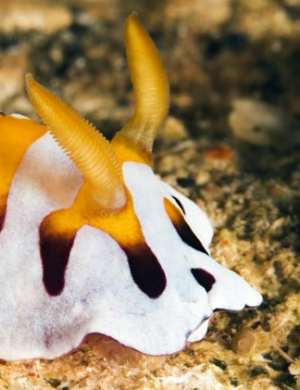
Dear Ken,
This is an animal I have been considering a probable colour form of Chromodoris roboi. If you look at the messages on this species you will find at least two other photos from Indonesia with this colour form. It may turn out to be a distinct species, but Western Australian specimens seem to be an interesting link between the two colour extremes.
One intersting feature in your photo is the hint od purple along the anterior end of the mantle, suggesting that it is one of the species with a deep purple patch on the underside of the anterior mantle. If you look at an earlier message from the Great Barrier Reef [message #10582] you will see that the spotted 'typical' form of C. roboi also has a purple underside to the anterior mantle, again suggesting a close relationship.
Best wishes,
Bill Rudman
Chromodoris roboi from Reunion Island
February 21, 2005
From: Philibert Bidgrain
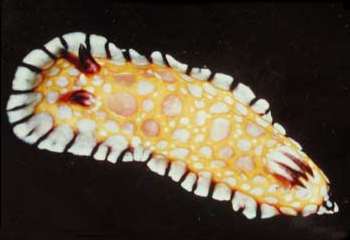
Reunion Island sea slugs.
We have only two specimens of Chromodoris roboi, this one and a juvenile specimen both observed by Maurice Jay a few years ago
Best Regards
Philibert Bidgrain
http://vieoceane.free.fr/runseaslug/indexslug.htm
pbidgrain@yahoo.fr
Bidgrain, P., 2005 (Feb 21) Chromodoris roboi from Reunion Island. [Message in] Sea Slug Forum. Australian Museum, Sydney. Available from http://www.seaslugforum.net/find/12976Thanks Philibert,
You can also add Stefaan Dewulf's record [message #12739] from Reunion Island.
Best wishes,
Bill Rudman
Chromodoris roboi from Reunion Island
December 28, 2004
From: Stefaan Dewulf
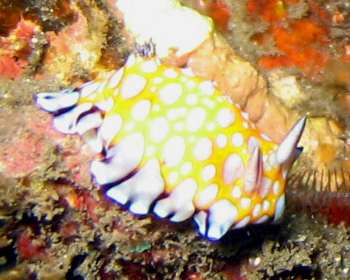
Dear Bill,
Please find enclosed some pictures we shot today [7 August 2004] of what be believe is Chromodoris roboi that was spotted during a night dive. Sorry for the pic quality, but it was shot during a night dive with strong swell not allowing us to get easy pictures.
As usual it was shot in Reunion Island (Indian Ocean), at the Cap Lahoussaye diving spot today (5-08-09). Depth was 11 m, water temperature approx 22°C.
It is the first time we spot this species on the island, though it has been spotted before by some other divers (it has been printed in the book Merveilles sous marines de la Réunion). I hope these information will help in defining the geographical location of this species. By the way, in one of our books, this nudi is referred as Hypselodoris is this a mistake ?
Best regards
Stefaan Dewulf.
dive@rando-reunion.com
Dewulf, S., 2004 (Dec 28) Chromodoris roboi from Reunion Island. [Message in] Sea Slug Forum. Australian Museum, Sydney. Available from http://www.seaslugforum.net/find/12739Thanks Stefaan,
Yes this is a valuable bit of information. With Valda Fraser's record [#1522] from South Africa, your find certainly shows this species occurs throughout the Indian Ocean. This is definitely a species of Chromodoris. Although they are in the same Family, there are quite major anatomical differences between Chromodoris and Hypselodoris.
Best wishes,
Bill Rudman
Chromodoris roboi from Nelson Bay
January 14, 2004
From: Dave Harasti
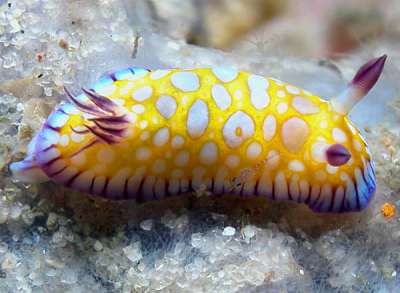
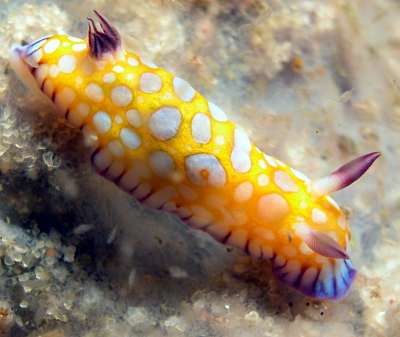
Hi Bill,
I have attached an image of a juvenile Chromodoris roboi, this individual was less than 1 cm long. It was found on Christmas Eve [24 December 2003] at Fly Point [Port Stephens, New South Wales, Australia]. Depth was 9 metres and water temp was 22 degrees. It's another one of those 'tropical' visitors that we get in the Bay over Summer. I think the sponge it was on could be its food source.
cheers,
Dave
www.daveharasti.com
diving@webone.com.au
Harasti, D., 2004 (Jan 14) Chromodoris roboi from Nelson Bay. [Message in] Sea Slug Forum. Australian Museum, Sydney. Available from http://www.seaslugforum.net/find/11774Thanks Dave,
I'll certainly try and get the sponge identified
Best wishes
Bill Rudman
Chromodoris roboi? from Indonesia
October 12, 2003
From: Paul Whitehead
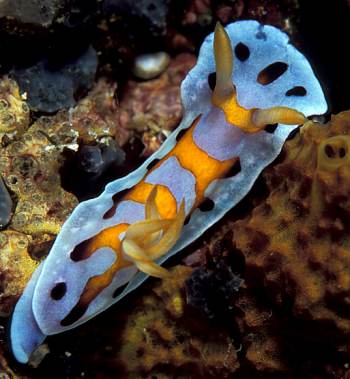
Dear Dr. Rudman,
I believe this may be a Chromodoris roboi but looking through several books and the examples on your site I don't seem to be able to match it exactly - it comes close to many examples in colouration / pattern but then does not match with gill or rhinopore colouration.
The photograph was taken at Lembeh Straits (Sulawesi, Indonesia) at 20 meters, length was 6 cm.
Paul
Whitehead@damnam.org
Whitehead, P., 2003 (Oct 12) Chromodoris roboi? from Indonesia. [Message in] Sea Slug Forum. Australian Museum, Sydney. Available from http://www.seaslugforum.net/find/11181Dear Paul,
Have a look at Stuart Hutchison's message which is of an animal almost identical in colour to yours. I suggested Stuart's animal may be a form of C. roboi but I agree it certainly lacks the purple in the gills and rhinophores. Building up photos like this is one good way of sorting out what's going on. It's also possible the sponge you photographed it on is its food sponge. Hopefully we will gradually accumulate enough information on the biology of these colour forms - and colour variation - to enable us to reach a sensible conclusion on how many distinct species fall inot this colour group.
Best wishes
Bill Rudman
Chromodoris roboi from Great Barrier Reef
July 29, 2003
From: Jukka-Pekka Salmenkaita
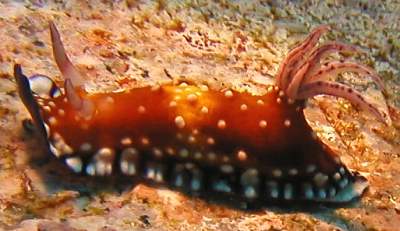
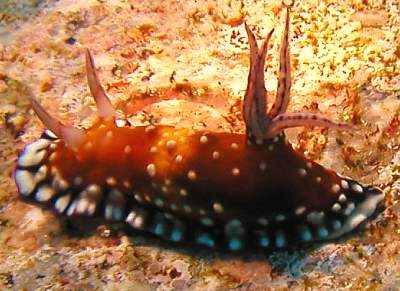
I found this specimen on "Steve's Bommie" memorial slate in GBR in 15th July 2002. [[15°30.017S 145°47.033E. Due west of south end of Ribbon Reef No 3, Great Barrier Reef. Queensland, Australia] Depth was around 25m. So far I have not been successful in identifying it, could you help?
Best regards,
Jukka-Pekka
jsalmenk@cc.hut.fi
Salmenkaita, J-P., 2003 (Jul 29) Chromodoris roboi from Great Barrier Reef. [Message in] Sea Slug Forum. Australian Museum, Sydney. Available from http://www.seaslugforum.net/find/10582Dear Jukka-Pekka,
This is Chromodoris roboi. It appears to be quite variable in colour but this is the usual Great Barrier Reef form
Best wishes,
Bill Rudman
Chromodoris roboi from Western Australia
April 19, 2003
From: Dan

Hi Bill
I was wondering if you could help me. I have taken this photo of a nudibranch on the wreck of HMAS Swan in Dunsborough, south west corner of Western Australia.
I have searched all over the internet to try and find out what it is called and haven’t been able to find it. I was wondering if you would know what it is or where else I might find the information. It would, of course, be fantastic to find a new nudibranch on our Wreck but I imagine this one has been found before. Any help you could give me would be much appreciated
Many Thanks
Dan <<...>>
Bay Dive & Adventures
www.baydive.com
Dan, 2003 (Apr 19) Chromodoris roboi from Western Australia. [Message in] Sea Slug Forum. Australian Museum, Sydney. Available from http://www.seaslugforum.net/find/9714Dear Dan,
This is what I think is a western Australian form of Chromodoris roboi. If you look at the other messages on this page you will see there is a bit of colour variation in the species, and in Western Australia all the photos I have seen are of this streaked, rather than spotted colour form. C. roboi has only recently been named so we still have a ot to learn about it. What it eats, what its eggs look like, its geographic range, it colour variability etc., etc., so any observations are very welcome.
Best wishes.
Bill Rudman
Chromodoris cf. roboi
October 21, 2002
From: Stuart Hutchison
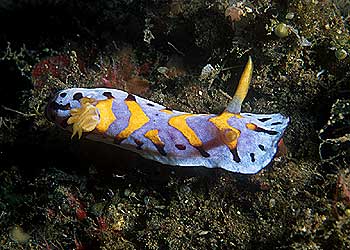
Hi Bill,
Here's another shot of the Chromodoris cf. roboi I sent last year.
Regards,
Stuart
stuart@stuarthutchison.com.au
Hutchinson,S., 2002 (Oct 21) Chromodoris cf. roboi. [Message in] Sea Slug Forum. Australian Museum, Sydney. Available from http://www.seaslugforum.net/find/5684Thanks Stuart,
Bill Rudman.
Chromodoris cf. roboi from Indonesia
November 14, 2001
From: Stuart Hutchison
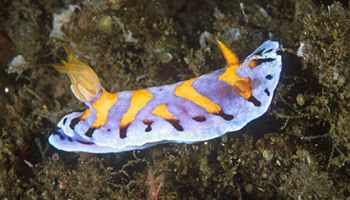
Hi again Bill,
long time no communicate! Mel and I have just come back from another fruitful trip to Tulumben, Bali, Indonesia. We found more different nudibranchs than ever before on this trip (I have photos of about 80 different species now). However, we haven't been able to find this guy in any of the good books (including Neville's latest).
Found at 45m depth (where there were lots of the regulars like Risbecia tryoni and Hypselodoris maculosa) on 16th Oct 2001, this one was about 35mm long, on the move in the coral garden (mostly small coral boulders, barrel sponges, hydroids and fans in the area) and the colours are pretty much reversed (missing some mantle colouring too) from Chromodoris roboi. What do you think??
Regards,
Stuart
stuart@stuarthutchison.com.au
Hutchison, S., 2001 (Nov 14) Chromodoris cf. roboi from Indonesia. [Message in] Sea Slug Forum. Australian Museum, Sydney. Available from http://www.seaslugforum.net/find/5610Dear Stuart,
An interesting animal. If you have a look at the lower photo on the Chromodoris roboi Page you will see an animal with much the same colour pattern as yours. However yours differs in having yellow gills and rhinophores. I am also not sure how much color variation there is in C. roboi. At the moment I am happy to accumulate photos of any chromodorids with this range of colours. Perhaps a pattern will emerge. In the meantime I will call your animal Chromodoris cf. roboi so that I don't forget its similarity to more 'typically' coloured animals.
Best wishes,
Bill Rudman.
Chromodoris roboi from the Great Barrier Reef
April 12, 2001
From: Erik Schloegl
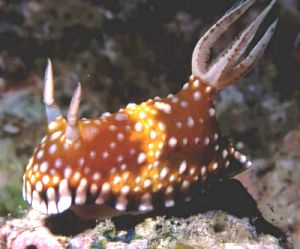
Dear Bill,
I looked through the species list of chromodorids, but couldn't find any that looked like this critter. Did I overlook it?
The photo was taken on 16 December 2000 at an unnamed bommie (well, we called it "40 meter bommie" after the depth of the sand bottom surrounding it) between the Ribbon Reefs, north of Port Douglas, Queensland. The depth was 10m.
Best wishes,
Erik
Erik.Schlogl@uts.edu.au
Schloegl, E., 2001 (Apr 12) Chromodoris roboi from the Great Barrier Reef. [Message in] Sea Slug Forum. Australian Museum, Sydney. Available from http://www.seaslugforum.net/find/4151Dear Erik,
I am afraid it is difficult to find what species are already on the Forum, other than by name. There are certainly ways to improve this but they would all require a rather massive input in time. Perhaps I'll win the lottery some day and be able to employ an assistant! In the meantime, your animal is Chromodoris roboi. Your photo is a useful addition as it shows the common tropical north-eastern Australian colour form.
Best wishes,
Bill Rudman
Chromodoris roboi from southwestern Australia
September 14, 2000
From: Craig Lebens
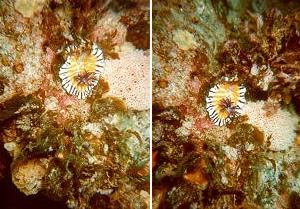
Dear Bill,
I have found this nudibranch which I can't find in any of the literature around or your site and I was wondering if you could identify it for me. The scanned photo isn't very clear, but if you want a hard copy of the photo I can post it to you for identification. I found it at 2 locations on the 8th & 9th of this month. First time was just on granite rock, and the second was (two different sightings) at a different location and they were on a wine coloured prostrate sponge-covered granite rock. Sand in both locations was approx 20-30 metres away, but both were found on rock.
What confuses me most is the colouring of the outside edge of the mantle is a bit like a flatworm and the inside colouring is kind of "tiger-striped" without the black. From the photo you can see it is a nudibranch, not a flatworm. Size wise the largest was 4 cm and the smallest was about 10mm. Our location here is Bremer Bay, on the south coast of Western Australia between Albany & Esperance. Our water temp at present is 16 to 17 degrees. Let me know what you think.
Craig Lebens
lebdive@comswest.net.au
Lebens, C., 2000 (Sep 14) Chromodoris roboi from southwestern Australia. [Message in] Sea Slug Forum. Australian Museum, Sydney. Available from http://www.seaslugforum.net/find/3016Dear Craig,
This is a colour form of Chromodoris roboi in which the white spots form white bands out to the mantle edge. Have a look at the top of the page and at Dave Freemantle's message below yours for some other photos. This streaky colour form seems to be quite usual in Western Australia.
Best wishes,
Bill Rudman.
Chromodoris roboi still here
June 14, 2000
From: A.Lumnitzer & D.Piotrowska
Dear Bill,
We were out at Kurnell [Sydney] last weekend. Did a night dive on Saturday and a morning dive on Sunday. The good news is that the little Chromodoris roboi is still in the very same spot (noted on both dives) as it was during the easter weekend, when we initially found it.
It seems like a happy, well-fed little chappy as it had not moved more than perhaps 30-40 cm from the first sighting, but it is still on the very same rock.
Regards
Akos & Donata
dna72@softhome.net
Lumnitzer, A. & Piotrowska, D., 2000 (Jun 14) Chromodoris roboi still here. [Message in] Sea Slug Forum. Australian Museum, Sydney. Available from http://www.seaslugforum.net/find/2567Dear Akos & Donata,
It seems to me that if has been in one place since late April then it must have a nearby food supply. In your first message you photographed it on what looks to be a purple sponge. What would be very useful would be to photograph any nearby sponges and see if they are getting smaller in size. If I am very lucky I might be able to get any likely sponge identified from a good photo.
Best wishes,
Bill Rudman.
Chromodoris roboi from Sydney
May 23, 2000
From: A.Lumnitzer & D. Piotrowska

Dear Bill
Please accept a better image of the Chromodoris roboi at Kurnell; we finally managed to take a nicer one. You may want to change it over on the forum.
Best wishes
Akos & Donata
akos72@hotmail.com
Lumnitzer, A. & Piotrowska, D., 2000 (May 23) Chromodoris roboi from Sydney. [Message in] Sea Slug Forum. Australian Museum, Sydney. Available from http://www.seaslugforum.net/find/2403Dear Akos & Donata,
Thanks for the good photo. At last I can put a photo of a 'typical' colour form at the top of the page.
best wishes,
Bill Rudman.
Chromodoris roboi from Sydney
April 19, 2000
From: Akos Lumnitzer
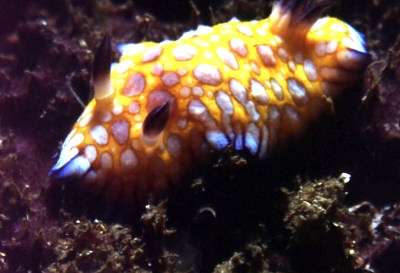
Dear Bill,
Could you please ID this beasty for us? My fiancee found it at 12 meters of depth off Kurnell, Botany Bay, Sydney, New South Wales, on the 9 April 2000.
It was about 2cm long.
Thanks
Akos
aglphoto@hotmail.com
Lumnitzer, A., 2000 (Apr 19) Chromodoris roboi from Sydney. [Message in] Sea Slug Forum. Australian Museum, Sydney. Available from http://www.seaslugforum.net/find/2287Dear Akos,
This is quite an interesting find for so far south, but considering the unusual oceanographic conditions on the east coast of Australia at present, with unseasonably warm water, it is not unexpected. This is Chromodoris roboi. It is nice to get a 'typical' spotted form to match the 'lined' form from western Australia. [See messages below]
Also of interest is the purple sponge on which it is crawling, which is most probably its food. Even when larvae of tropical animals survive the journey south, they still have to find either a colony of their tropical food, which has also made the journey successfully, or find a temperate water substitute.
Best wishes,
Bill Rudman.
Chromodoris from Perth, Western Australia
March 16, 2000
From: David Freemantle
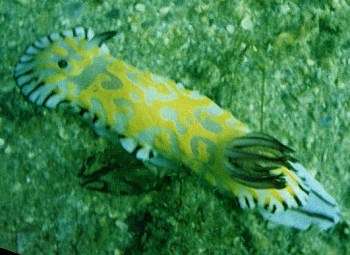
Dear Bill
Could you please help me identify the nudibranch in the attached photos, taken at the South Mole, Fremantle, Perth, Western Australia on the 12 March 2000 at 6 metres. It certainly has a distinct pattern and there were half a dozen specimens seen at the time, which led me to believe it is common, yet after searching my references for an hour I still could not find anything that looks all that close.
Thanks in advance for your help.
David Freemantle
scubadav@rock.upnaway.com
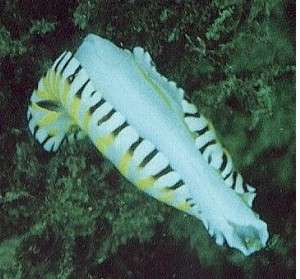

Dear Dave,
This is Chromodoris roboi. Your animals seem to have an intermediate colour form between the photo at the top of the page, which is also from Perth, and the more typical spotted form illustrated in various messages on this page. It doesn't seem to be that common anywhere, but your find of a group of animals may reflect a chance settling of a group of larvae. Another alternative is that its food sponge is reasonably rare in Perth, so any settling larvae will be concentrated on one or a few sponge colonies.
Nice photos,
Bill Rudman.
Chromodoris roboi? from Sth Africa
November 15, 1999
From: Valda Fraser
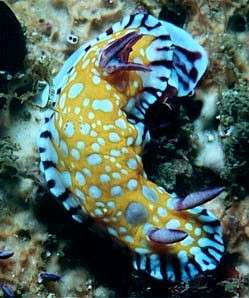
Dear Bill
Just look at this beauty I photographed last weekend! I would love to know its name. I cannot find anything like it in any of my books.
Locality: South Coast KwaZulu/Natal - SOUTH AFRICA. Park Rynie. Rocky Reef - 25m, November 1999. Size: 55mm.
Regards
Valda Fraser
iti04937@mweb.co.za
Fraser, V., 1999 (Nov 15) Chromodoris roboi? from Sth Africa. [Message in] Sea Slug Forum. Australian Museum, Sydney. Available from http://www.seaslugforum.net/find/1522Dear Valda,
I think this is another interesting find. I am pretty sure it is Chromodoris roboi or at least something very closely related to it. If you look through the messages on C. roboi you will see it is quite varaible in colour.
It was only named last year and has only been reported from the western Pacific so your find is a major jump in its known distribution.
Best wishes,
Bill Rudman.
Chromodoris roboi from Heron Island, GBR
June 28, 1999
From: Julie Marshall
Dear Bill,
The report of Chromodoris roboi from Heron Island, Great Barrier Reef last week was the seventh record of this species from Heron Island. Richard Willan found four specimens during the period 1974 to 1980 and I found two specimens in 1991 and 1994, both during the summer period.
Julie Marshall
j.marshall@latrobe.edu.au
Thanks Julie,
Any photos, observations you would like to contribute to the Forum would be very welcome,
Best wishes,
Bill Rudman.
Chromodoris roboi from Heron Island
June 22, 1999
From: Nerida Wilson


Dear Bill,
Could you confirm this is Chromodoris roboi please. It is from Tenements 1, Heron Island, Great Barrier Reef, Queensland. I don't think the photos are good enough for you to publish on the Forum.
Nerida Wilson.
University of Queensland.
nwilson@zoology.uq.edu.au
Wilson, N., 1999 (Jun 22) Chromodoris roboi from Heron Island. [Message in] Sea Slug Forum. Australian Museum, Sydney. Available from http://www.seaslugforum.net/find/965Dear Nerida,
Yes this is the 'typical' colour form of Chromodoris roboi. Don't feel embarassed about your photos. Its often hard to take good photos in the field, and in most cases a less than perfect photo is sufficient to identify an animal. The Forum is a 'working' site where I hope people are willing to put 'ideas in progress', less than perfect photos etc - just like they would if they were discussing ideas with friends.
I try and put the best photos I can find on the site so they can be used as a resource for identifications etc, but I am more than happy to put underexposed, overexposed, out of focus etc pics if they have a story to tell, represent a new record, or otherwise create an important bit of information.
Best wishes,
Bill Rudman.
Re: Striped Chromodoris roboi?
April 15, 1998
From: Richard Willan
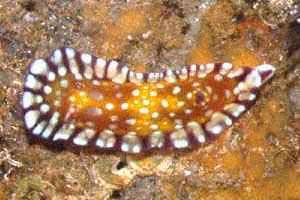
Dear Bill
Here's one of my slides of Chromodoris roboi from eastern Australia. The animal was nestling in a crevice on the side of a vertical cliff wall, 13m, on the eastern side of Julian Rocks off Byron Head, northern New South Wales, 13 July 1980. I think your picture of the gold-striped "form of C. roboi" from WA is definitely a different species. I have seen two specimens from WA (and have superb slides of it by Reg Gentle) and it is consistently different to roboi. I have now got a set of 13 slides of roboi from the man himself, Bob Bolland, and the ONLY difference between roboi and the species in Willan & Coleman (Nudibranchs of Australasia, 1984) is the coloration on the gills - a series of red blotches in the Australian material. Unfortunately Gosliner & Behrens didn't describe the full colour variation in the specimens from Okinawa. So now I believe the eastern Australian specimens are really Chromodoris roboi.
Richard Willan
Museum & Art Gallery of the Northern Territory
richard.willan@nt.gov.au
Willan, R., 1998 (Apr 15) Re: Striped Chromodoris roboi?. [Message in] Sea Slug Forum. Australian Museum, Sydney. Available from http://www.seaslugforum.net/find/46Thanks for the slide and comments. I think I'll leave the striped "form" from Western Australia under Chromodoris roboi at the moment in the hope that it will generate some interest amongst divers to go and see if they can find and photograph some intermediate colour forms... Bill Rudman
Rudman, W.B., 1998 (Apr 15). Comment on Re: Striped Chromodoris roboi? by Richard Willan. [Message in] Sea Slug Forum. Australian Museum, Sydney. Available from http://www.seaslugforum.net/find/46Striped Chromodoris roboi?
April 4, 1998
From: Lindsay Warren
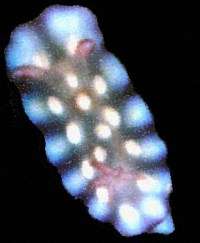
Dear Bill
Many thanks for coming back to me so quickly on Noumea crocea. The next one attached (? Chromodoris) was less than 1cm long and found in a similar location - ie between 0-60 ft of water on a leeward wall of Pulau Hoga, a very small island next to Pulau Kaledupa in the Tukang Besi islands, SE Sulawesi. The wall is heavily covered in both hard and soft corals as opposed to a sandy or rubbly bottom. The edge of the mantle is wavy with mid-blue edges, pale blue as one looks towards the centre back which was sage green with conspicuous creamy spots. The darker intervening patches are purely shadow rather than colour markings. The gills and rhinophores where translucent white with burgundy edging to them. The gills had five simple branches. The front edge of the mantle was quite broad which it would 'flap' as it moved.
Many thanks
Lindsay Warren
100014.2112@compuserve.com
Warren, L., 1998 (Apr 4) Striped Chromodoris roboi?. [Message in] Sea Slug Forum. Australian Museum, Sydney. Available from http://www.seaslugforum.net/find/159This is almost certainly a juvenile. It is probably Chromodoris roboi which has only recently been named. It is has been recorded from Ryukyu Islands, Okinawa, and both eastern and western Australia. If your animal is the same species it helps fill in a gap in the distribution. The normal colour pattern consists of a yellowish background colour and white or translucent spots. A good picture of a typically coloured animal can be found on Bob Bolland's site.
The photo I have included here from Western Australia is of an animal in which the translucent spots have become tranverse streaks across the mantle...Bill Rudman.
Rudman, W.B., 1998 (Apr 4). Comment on Striped Chromodoris roboi? by Lindsay Warren. [Message in] Sea Slug Forum. Australian Museum, Sydney. Available from http://www.seaslugforum.net/find/159